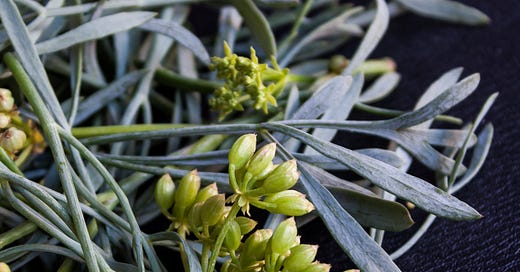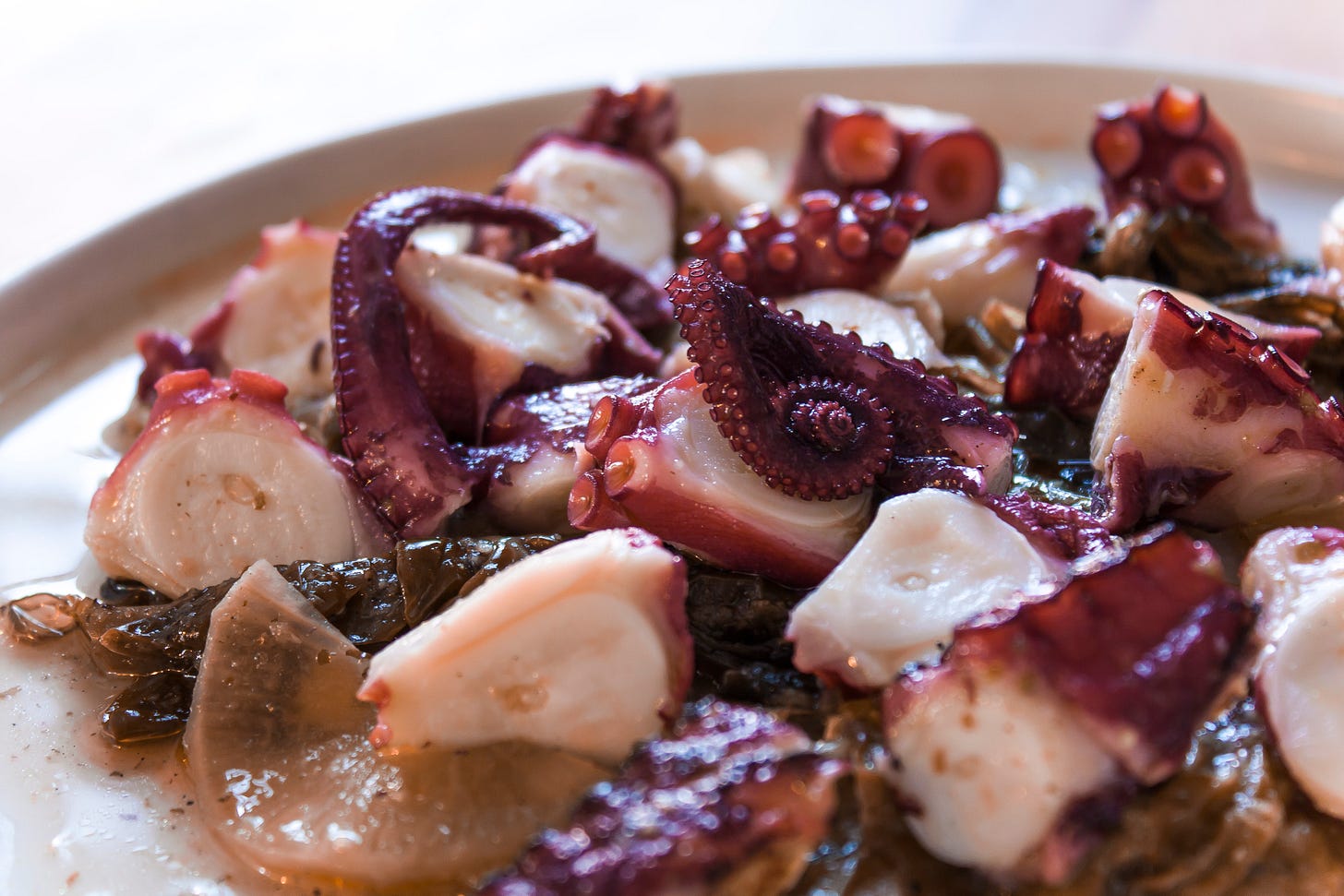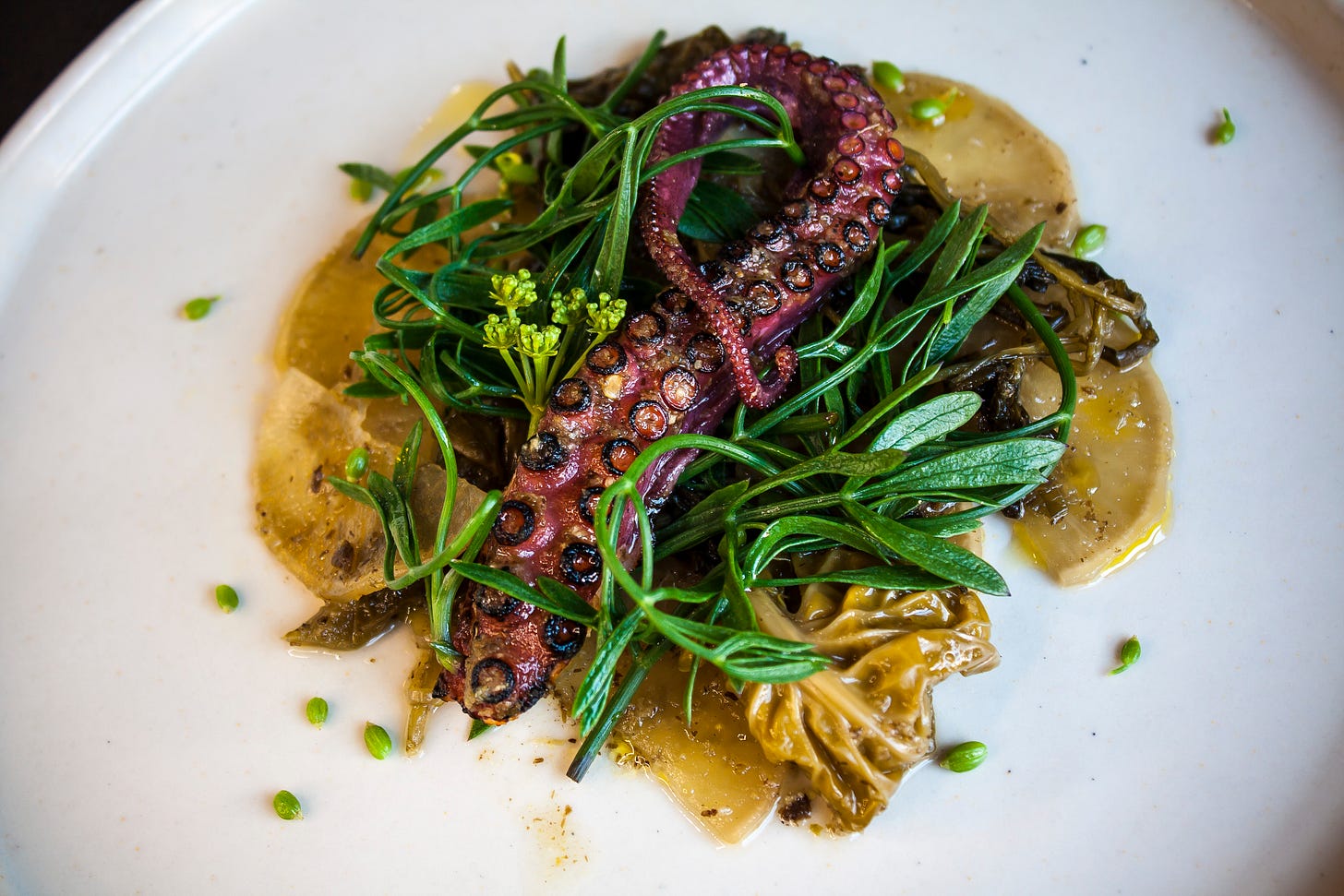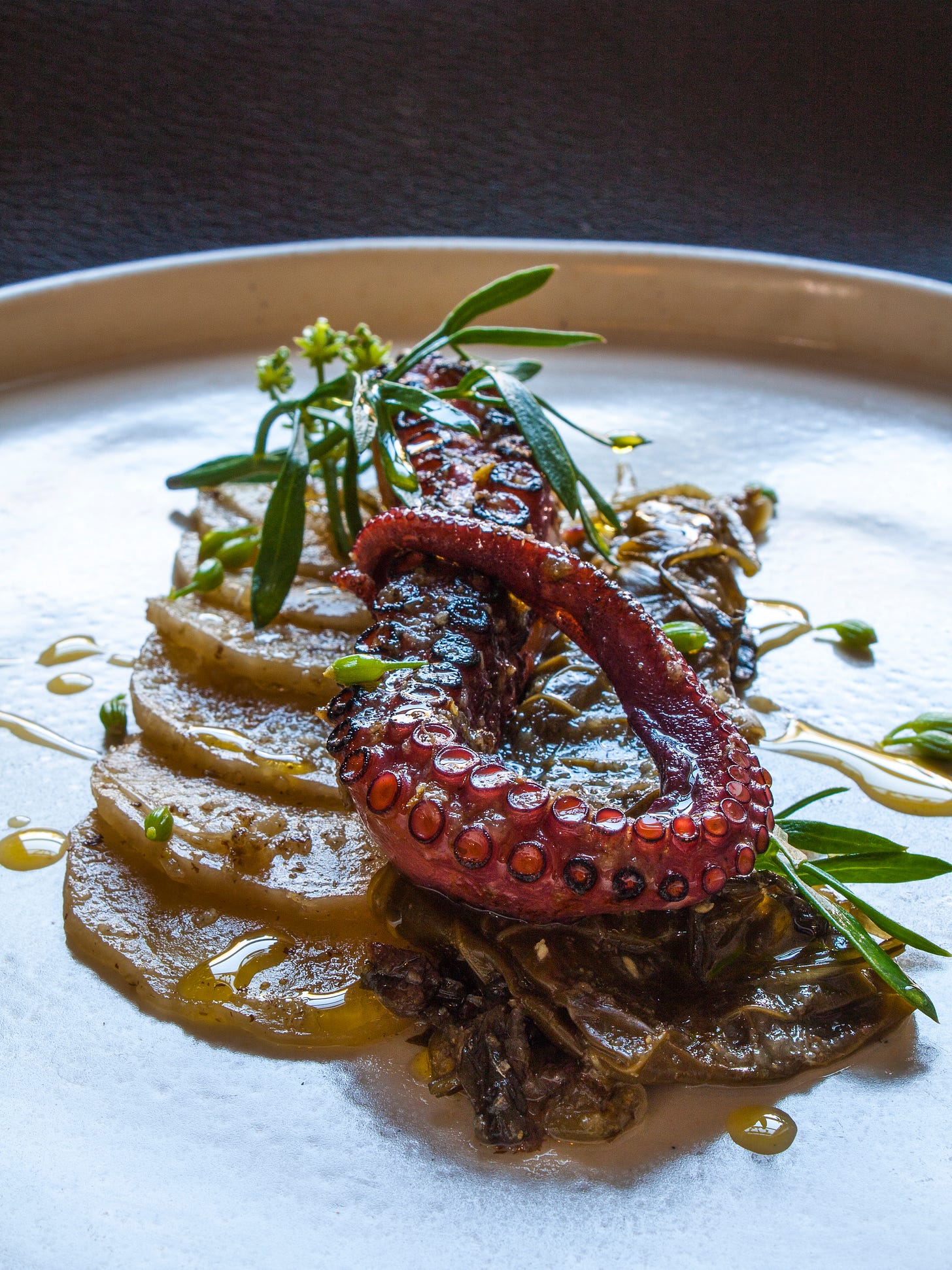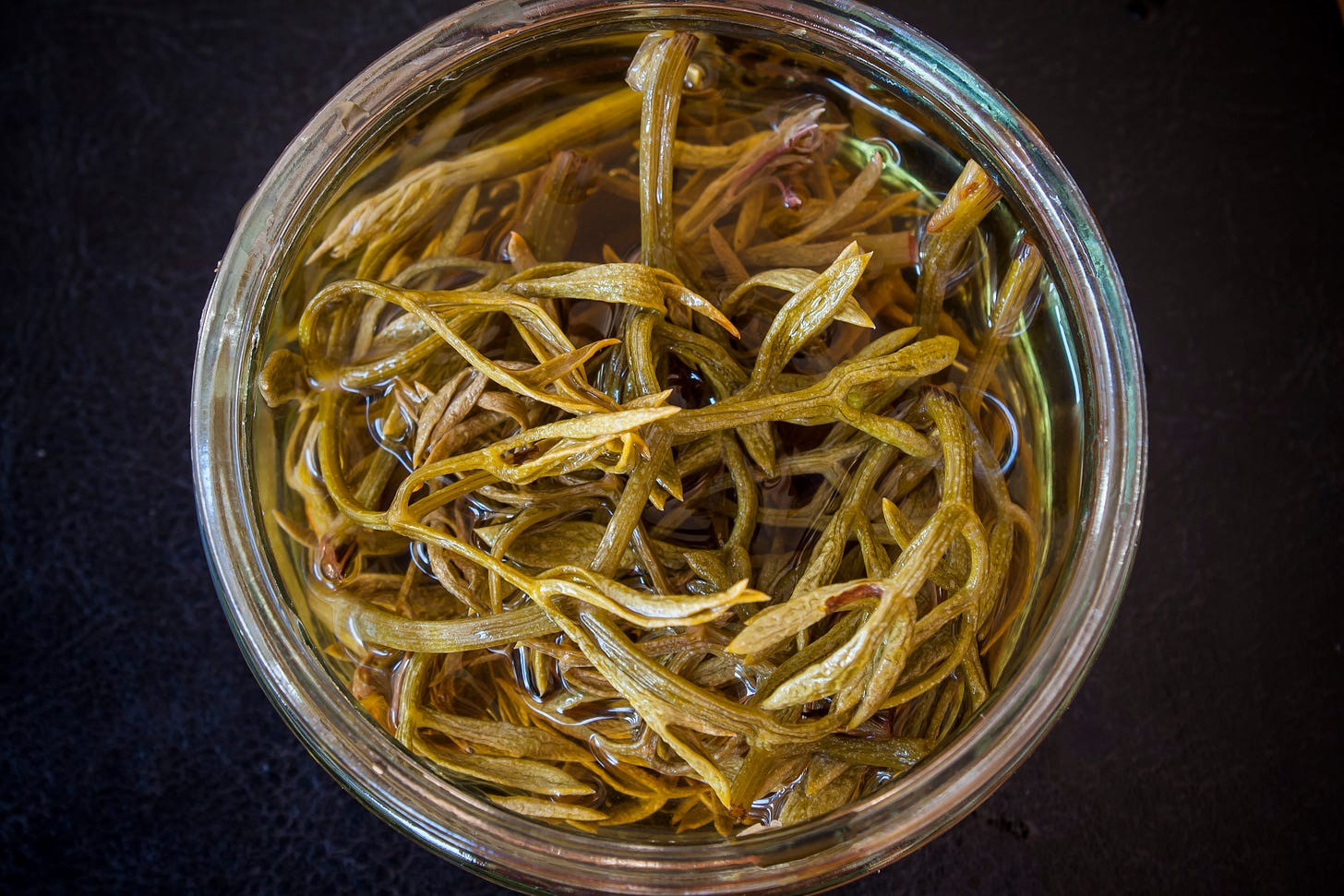Foraging in December... ROCK SAMPHIRE
Plenty to look for... bittercress, mustard, sorrel, dandelion root, dog rose, garlic mustard, sea beet, rock samphire, alexander, douglas fir, crab apples, velvet shank, wood sorrel, navelwort...
Wood ear, crow garlic, ground ivy…
ROCK SAMPHIRE
You must love carrots to like rock samphire. Not ‘just’ because it belongs to the carrot family - but it actually tastes pretty much like a carrot. Spread around the coast - super easy to find and even easier to prepare. Traditionally pickled in countries like Croatia or Italy - or enjoyable to eat raw in salads or briefly sauteed as a garnish. Rich in vitamin C, vitamins E and K and also a great source of iodine, carotenoids and flavonoids, full of antioxidants and omega 3 fatty acids. Anything else? Oh yeah - and it is available pretty much all year around. Great great little plant.
OCTOPUS WITH SEAKIMCHI AND ROCK SAMPHIRE
I love octopuses. I love the animal - I believe it’s one of the most intelligent creatures existing on the planet. So I’m actually very happy that buying octopus ‘meat’ is not a cheap deal. I do respect it so I am happy to pay a fairly high price for it once in a while when I fancy eating some. It tastes wonderful after cooking for several hours. The body is pure protein so you can’t rush the process - make sure you don’t make any plans for that day when you decide to cook a whole one. I did cheat here - but also paid the price for it. I bought already-cooked octopus legs. I still marinated them in the juice of my homemade green ‘seakimchi’ for some hours then grilled them on an open fire. OMG salivation.’
Ingredients (for 2):
3-4 pieces of cooked octopus legs (or be brave and cook a whole one off - you can freeze it down without any issues)
kimchi (I was using my homemade seakimchi - but feel free to buy any raw artisanal kimchi
a couple of handfuls of rock samphire
lemon juice, salt, pepper, posh olive oil
Tip:
Not to worry if you are not the fermentation type of dude. Or if you are just too busy to play with jars and salt percentages. Sneak down to your Asian store and buy Korean-style kimchi. No shame but fingerlicking.
Whisper some prayers to find a cooked octopus. It’s worth checking your fishmonger first. I don’t want to put you off cooking a whole raw one - there are some great (Spanish) recipes around online (with lots of red wine) - just be careful not to think it’s going to take as long as a chicken to cook. If you are free and have a huge pot to fit on your stove (or oven) go for it. It will be even more delicious.
Tip:
cooking octopus in a pot of boiling liquid (~100 degrees) - depending on the size will take a couple of hours
pressure cooker: might can take only 15-20 minutes but once you closed your pot you cant know for sure whats happening inside till you finish the cooking by opening the pot - worth experimenting the right time
sous vide cooking: at ~80 degrees takes about 5-6 hours
I cut my cooked octopus into medium-sized pieces and covered them with some pureed kimchi - to soften it even more and give a punchy flavour.
Making seakimchi is super easy - it needs only a couple of ingredients (you can stick with the traditional Korean red type or be adventurous by using different vegetables and foraged goods) to start the fermentation and a bit of time to wait till the flavours blend together by nature. Here I pureed some to macerate the octopus and left some in bigger pieces on the side for garnish.
Get an open fire on - it doesn’t need to be* a huge BBQ - not everyone is lucky to have that option. I usually use the gas stove burners or my high-power blow torch. Burning the skin gives a heavenly taste. You can choose to heat up a non-stick pan dry - and chuck the octopus pieces in - be brave and leave it on for a good while - the only thing you should be afraid of is your smoke alarm. After you manage to get some golden/black tone to the ‘meat’, take the pan off the heat, then toss some oil in the same pan with a couple of handfuls of rock samphire and put it back to the heat. Count back from 10 and it’s done. Season with lemon juice, salt, pepper if you wish… and a good splash of extra virgin olive oil (make sure you have some great crusty bread around to wipe the plates out…) Another MIRACLE.
KIMCHI FROM THE SEA…
2 tbsp salt and same sugar for curing
handful of alexander greens
2 handfuls of seakale
1 handful of dehydrated wakame seeweed
3-4 chopped sea leeks
1 big daikon sliced
2-3 sweet pears/ apples
10-15 cloves of garlic
2 thumb sized ginger
3-4 green chillies (if you like it hot go for scoth bonnet or birds eyes lol)
4 tbsp fish sauce (optional but everything is better with fish sauce LOL)
4tbsp light soy sauce
2 tsp of salted fermented shrimps (optional, you can just use miso instead)
Lets play this rough. Of course you can spend s couple of hours chopping and slicing all the vegetables in a precise way to a specific size - but I am not too fussy about that. We are looking for the ‘sameish’ size so everything will ferment in the ‘sameish’ time. Just get freestyle and chop your vegetables. Once you have all prepared - lets deal with the heart of the kimch - the sauce. Get the garlic, ginger, chillies, fruits, fish and soy sauce with the shrimp paste - blend all of this together to a paste. This will be the marinade for the vegetables.
First massage the sugar and salt into the vegetables. This will make them sweat so you will have a nice juice going on very soon on the bottom of your bowl. After a couple of hours wash this liquid off and mix your chopped vegetables with your marinade.
Tip: if you can think ahead a day you can leave your vegetables in a 5% brine overnight - will stay crunchier for longer.
Fill up your sanitised jars and try to push it down enough so it will have some space on the top for expanding. Leave it minimum a week to ferment at room temperature but I like it minimum a month old. You can slow age after a week in the fridge.
Tip2: to make your kimchi even faster - I mix a tsp of sourdough starter with the marinade (or you can use other culture like whey or fresh sauerkraut juice) to give a superman kickstart!
WHAT ELSE TO USE ROCK SAPMHIRE FOR?
It is a small plant so you it for everything you would use a small healthy delicious plant. You can eat row - in salads or cooked as a garnish or in sauces. I pickled them before just like fermented as well with 2% salt and it stayed delicious in both ways (maybe the harsh flavour becomes a bit less harsh so more pleasant).
Dont forget, it taste like carrot so just use it everywhere instead of an actual carrot :)

